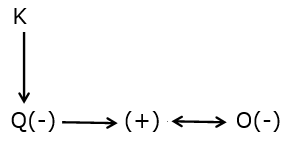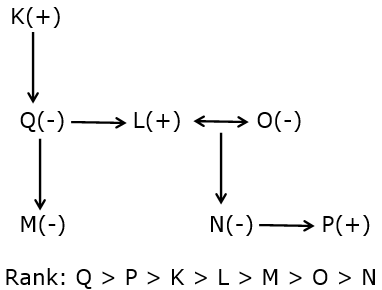Question
How K is related to the one who got the third lowest
rank? Study the following information carefully and answer the given questions. Seven persons – K, L, M, N, O, P, and Q from a family of three generations participated in a painting competition and got different ranks from 1 to 7 where ‘1’ is the highest rank and ‘7’ is the lowest rank. No two persons got the same rank. Only one person got lower rank than K’s daughter-in-law. Q is the sister-in-law of O and vice-versa. Q is the only daughter of K. O doesn’t have any siblings. K got higher rank than both L and M but not as much as P, who didn’t get the highest rank. N is the only daughter of L, who got three ranks higher than N. Q is the paternal aunt of P, who got immediate lower rank than Q. Q’s daughter got immediate higher rank than L’s wife. L is not married to K. The gender of K and M is not same.Solution
Only one person got lower rank than K’s daughter-in-law.
Q is the sister-in-law of O and vice-versa.
Q is the only daughter of K.
O doesn’t have any siblings.
That means, O must be daughter-in-law of K.
K got higher rank than both L and M but not as much as P, who didn’t get the highest rank.
Based on the above given information we have: For Ranking:
For Ranking:
__ P > K > L, M
Again, we have:
N is the only daughter of L, who got three ranks higher than N.
Q is the paternal aunt of P, who got immediate lower rank than Q.
From the above given statement we have:
Q > P > K > L, M
Again, we have:
Q’s daughter got immediate higher rank than L’s wife.
L is not married to K.
That means, L must be married to O.
Since, M is the only remaining person, thus M must be daughter of Q.
The gender of K and M is not same.
Thus, K must be the father of Q.
Based on the above given information we have:
As per the Bharatiya Nyaya Sanhita, 2023 ____________ means a group of two or more persons who, acting either singly or jointly, as a syndicate or gang ...
What happens to suits and applications, including those under the Arbitration and Conciliation Act, 1996, related to a commercial dispute of a Specified...
Which of the following scenarios would most likely be punishable as mob lynching under the Bharatiya Nyaya Sanhita, 2023?
Who is considered as the Union Executive and the Head of the State as per the Indian Constitution?
With reference to the Limitation Act, 1963 "limitation period for filing the suit for possession of immovable property based on previous possession and...
A sessions court requires permission of High Court to pass _______?
Indian Evidence Act does not expressly mention about
Who will indemnify the beneficial owner in case of negligence caused by the depository or participant?
Which is Court of record as per Article 129 of the Indian Constitution?
Cultivate personally means under the Chhattisgarh land Revenue Code:


